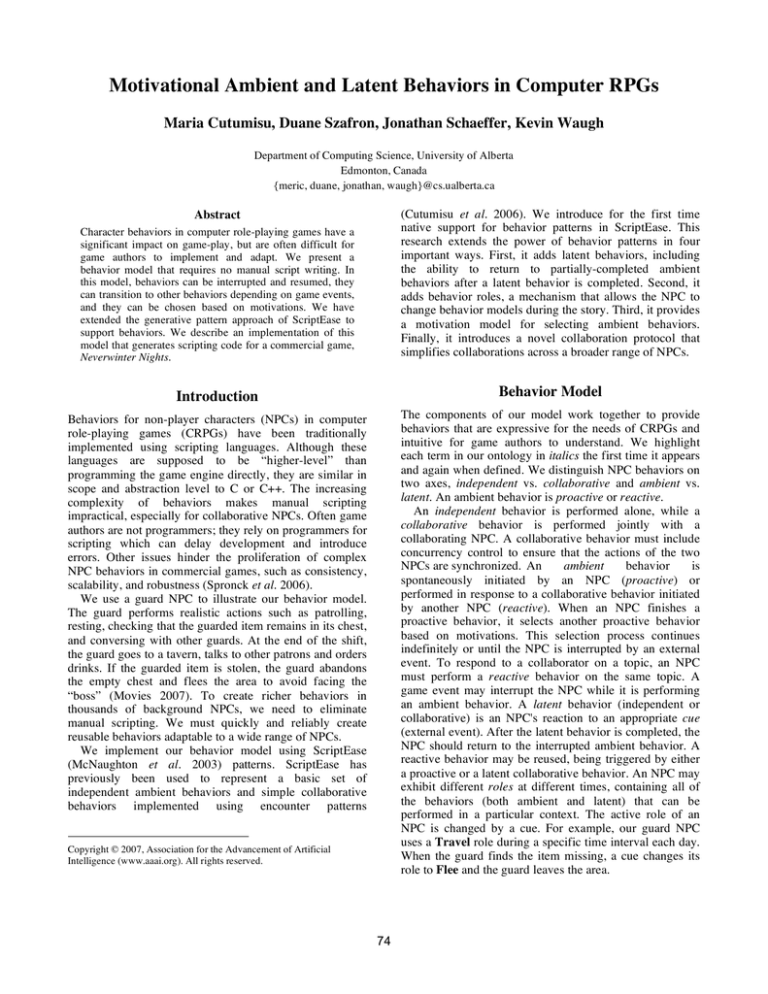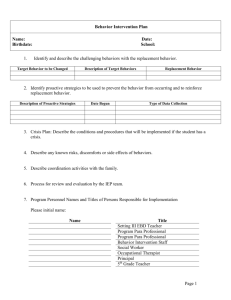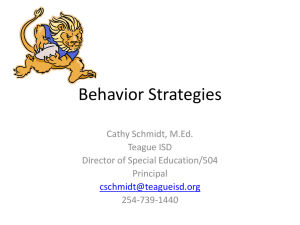
Motivational Ambient and Latent Behaviors in Computer RPGs
Maria Cutumisu, Duane Szafron, Jonathan Schaeffer, Kevin Waugh
Department of Computing Science, University of Alberta
Edmonton, Canada
{meric, duane, jonathan, waugh}@cs.ualberta.ca
Character behaviors in computer role-playing games have a
significant impact on game-play, but are often difficult for
game authors to implement and adapt. We present a
behavior model that requires no manual script writing. In
this model, behaviors can be interrupted and resumed, they
can transition to other behaviors depending on game events,
and they can be chosen based on motivations. We have
extended the generative pattern approach of ScriptEase to
support behaviors. We describe an implementation of this
model that generates scripting code for a commercial game,
Neverwinter Nights.
(Cutumisu et al. 2006). We introduce for the first time
native support for behavior patterns in ScriptEase. This
research extends the power of behavior patterns in four
important ways. First, it adds latent behaviors, including
the ability to return to partially-completed ambient
behaviors after a latent behavior is completed. Second, it
adds behavior roles, a mechanism that allows the NPC to
change behavior models during the story. Third, it provides
a motivation model for selecting ambient behaviors.
Finally, it introduces a novel collaboration protocol that
simplifies collaborations across a broader range of NPCs.
Introduction
Behavior Model
Behaviors for non-player characters (NPCs) in computer
role-playing games (CRPGs) have been traditionally
implemented using scripting languages. Although these
languages are supposed to be “higher-level” than
programming the game engine directly, they are similar in
scope and abstraction level to C or C++. The increasing
complexity of behaviors makes manual scripting
impractical, especially for collaborative NPCs. Often game
authors are not programmers; they rely on programmers for
scripting which can delay development and introduce
errors. Other issues hinder the proliferation of complex
NPC behaviors in commercial games, such as consistency,
scalability, and robustness (Spronck et al. 2006).
We use a guard NPC to illustrate our behavior model.
The guard performs realistic actions such as patrolling,
resting, checking that the guarded item remains in its chest,
and conversing with other guards. At the end of the shift,
the guard goes to a tavern, talks to other patrons and orders
drinks. If the guarded item is stolen, the guard abandons
the empty chest and flees the area to avoid facing the
“boss” (Movies 2007). To create richer behaviors in
thousands of background NPCs, we need to eliminate
manual scripting. We must quickly and reliably create
reusable behaviors adaptable to a wide range of NPCs.
We implement our behavior model using ScriptEase
(McNaughton et al. 2003) patterns. ScriptEase has
previously been used to represent a basic set of
independent ambient behaviors and simple collaborative
behaviors implemented using encounter patterns
The components of our model work together to provide
behaviors that are expressive for the needs of CRPGs and
intuitive for game authors to understand. We highlight
each term in our ontology in italics the first time it appears
and again when defined. We distinguish NPC behaviors on
two axes, independent vs. collaborative and ambient vs.
latent. An ambient behavior is proactive or reactive.
An independent behavior is performed alone, while a
collaborative behavior is performed jointly with a
collaborating NPC. A collaborative behavior must include
concurrency control to ensure that the actions of the two
NPCs are synchronized. An
ambient
behavior
is
spontaneously initiated by an NPC (proactive) or
performed in response to a collaborative behavior initiated
by another NPC (reactive). When an NPC finishes a
proactive behavior, it selects another proactive behavior
based on motivations. This selection process continues
indefinitely or until the NPC is interrupted by an external
event. To respond to a collaborator on a topic, an NPC
must perform a reactive behavior on the same topic. A
game event may interrupt the NPC while it is performing
an ambient behavior. A latent behavior (independent or
collaborative) is an NPC's reaction to an appropriate cue
(external event). After the latent behavior is completed, the
NPC should return to the interrupted ambient behavior. A
reactive behavior may be reused, being triggered by either
a proactive or a latent collaborative behavior. An NPC may
exhibit different roles at different times, containing all of
the behaviors (both ambient and latent) that can be
performed in a particular context. The active role of an
NPC is changed by a cue. For example, our guard NPC
uses a Travel role during a specific time interval each day.
When the guard finds the item missing, a cue changes its
role to Flee and the guard leaves the area.
Abstract
Copyright © 2007, Association for the Advancement of Artificial
Intelligence (www.aaai.org). All rights reserved.
74
proactive behavior is triggered by a motivation-based cue,
while a reactive behavior is triggered by a reactive-based
cue initiated by the collaborator. Our cue-based timing
mechanism, general purpose cues (based on game state)
and motivational scheme for specifying NPC behaviors
allow us to express all of the semantics provided by the
character AI in Oblivion. Our generative pattern technique
allows the game author to rely on a catalog of pre-defined
behavior patterns that generate scripts automatically.
Every role contains a set of proactive behaviors. The
NPC selects a proactive behavior based on motivation (M)
attribute values that are stored in a motivation vector and
updated as the game progresses. The Guard Motivation
contains three attributes: Duty, Tiredness, and Threat.
Duty refers to the NPC’s sense of duty and it can change
during the guard’s shift. When an ambient behavior (Rest)
is completed, its motivation vector is updated (Tiredness
is reduced, while Duty and Threat are increased, as shown
in the Rest update clause of Figure 1). The selection value
for a proactive behavior is a constant plus the dot product
of the motivation vector and the proactive vector. The
current selection value for the Rest behavior, S(Rest) = cRest
+ wRest •m, is shown at the bottom of Figure 1. The
motivation vector contains the current values of the
motivation attributes. The proactive vector contains one
weight, wi, for each motivation attribute that reflects how
important this attribute is in selecting the motivation.
Behavior Patterns
We have captured the guard’s behaviors and other common
NPC behaviors into ScriptEase behavior patterns, a
category of reusable generative design patterns (Gamma et
al. 1994).
Figure 1. The structure of a behavior pattern.
To use an existing behavior pattern (e.g., Guard), an
author only needs to instantiate the pattern and set its
options. However, to extensively adapt existing patterns or
to create new patterns using pre-built components, an
author must understand the structure of behavior patterns.
In Figure 1, the Guard instance has been opened to reveal
some of its components. The Guard role (B) includes a
cue (→), Arrive, to activate this behavior when the guard
enters the area of the container, a motivation (M), Guard
Motivation, three independent ambient behaviors (P),
Patrol, Rest and Check, one collaborative ambient
behavior (P), Converse-Talk, one collaborative reactive
ambient behavior (R), Converse-Listen, and two
independent latent behaviors (L), Warn and Attack. Each
proactive, reactive and latent behavior is based on a
ScriptEase abstract behavior. When instantiating an
abstract behavior, the designer selects the particular kind of
cue that triggers it and that determines which kind of
behavior it will be: proactive (P), reactive (R) or latent (L).
Once it is instantiated, it is referred to as a basic behavior.
A basic behavior consists of its cue (→), an update clause
(U) that updates the motivation, and a set of tasks (T)
composed of actions (A). Tasks ensure atomicity and
synchronization within a collaborative behavior. If a
proactive behavior is interrupted by a latent behavior, the
NPC restarts the interrupted task when the latent behavior
is finished. A cue (→) is used to activate a role (the Guard
role is activated when the NPC enters the area of the
container) or to trigger a basic behavior (the Warn latent
behavior is triggered by a range-based Near cue). Each
Collaborative Behaviors
In our model, an NPC resumes an interrupted ambient
behavior after completing a latent behavior. Moreover, an
NPC can perform an ambient behavior while waiting for its
collaborator to complete a lengthy behavior. We have
developed a simple collaborative system that authors can
use to specify abstract behaviors that can constitute
proactive and reactive components in a collaborative
behavior. For example, a collaborative behavior between a
guard and a friendly NPC can be established if the guard
has a proactive behavior (Converse-Talk) on a topic
(“weather”) and the collaborator has a reactive behavior
(Converse-Listen) on the same topic. The collaborative
model looks for any NPC who has a reactive behavior on
that topic, makes eye-contact (it is not busy in a
collaborative or latent behavior) and satisfies the
conditions of the initiator’s collaborative behavior. Both
NPCs concurrently execute pairs of tasks that comprise
their respective behaviors until completion. Scripting code
that synchronizes these tasks is generated automatically.
Behavior Dispatch
The key to our behavior model is dispatching the
appropriate behavior at any time and remembering what
behavior to return to when an interrupting behavior is
complete.
75
To validate the expressiveness of our behavior patterns,
we took less than an hour to replace all the manual scripts
for the ambient characters of the Prelude module of the
NWN official campaign with the code generated from our
behavior patterns. This exercise showed that the new
behavior approach is efficient, robust, and easy to use.
Conclusions
We designed our behavior system to satisfy the
computational and functional requirements of commercial
computer games (Spronck et al. 2006). Our model and
implementation are robust, flexible, extendable, and
scalable to thousands of ambient NPCs (hundreds active at
a time), while requiring minimal CPU resources. Our NPC
behaviors are clear, since the intent of ScriptEase patterns
is evident from their names and from an inspection of their
components. ScriptEase generates commented scripts for
NPC behaviors that are easily interpretable even for nonprogrammers and allows the specification of behaviors at a
higher level, making adaptation, experimentation, and
testing easy. Our system provides variety in selecting roles
and in choosing motivational proactive behaviors, and
supports the generation of unpredictable, but rational and
consistent behaviors. We developed a concurrency
mechanism that solves the synchronization problems of
collaborative, interruptible and resumable behaviors and
we can generate engaging behaviors without writing code.
Figure 2. Behavior dispatch in the behavior model.
When an NPC is created in the game, a custom behavior
event is triggered on the NPC, as illustrated in Figure 2.
Then, a role is selected using a cue and the role invokes a
spinner that may choose a proactive behavior based on the
role’s motivation. This new proactive behavior triggers a
set of tasks composed of the actions that implement the
behavior. At any time, an NPC can be performing a latent
(independent or collaborative), a collaborative (proactive
or reactive), or an independent behavior. An NPC has four
queues: one for latent behaviors, two for ambient
collaborative behaviors and one for ambient independent
behaviors. Each queue holds the tasks not yet finished for
that basic behavior. The spinner first tries to select and
perform a task from one of the queues. If it is successful, it
dequeues the task and calls the role selector. The spinner
picks tasks from the queues in this priority order: latent,
collaborative, independent. When picking a task from a
collaborative queue, the spinner checks if the collaborator
has signalled the start of the next task. If not, the spinner
waits for a short time and checks again. If it still has not
been signalled, it proceeds to the next ambient queue or
selects a new proactive behavior. When a task from the
collaborative queue is dequeued, the spinner signals the
collaborator that it can proceed to its next task. If the
collaborator has not finished, the waiting NPC cancels the
collaboration, since the collaborator may be blocked. This
ensures no deadlock or indefinite postponement for NPCs.
Both NPCs spin again and may execute the same protocol.
Acknowledgments
This research was supported by the Natural Sciences and
Engineering Research Council of Canada (NSERC), the
Institute for Robotics and Intelligent Systems (IRIS), and
Alberta’s Informatics Circle of Research Excellence
(iCORE). We thank our University of Alberta Women in
Scholarship, Engineering, Science and Technology
(WISEST) student, Stephie Cadek, along with the other
current ScriptEase team members, Curtis Onuczko, Jeff
Siegel, Allan Schumacher, and Robin Miller.
Behavior Pattern Evaluation
We conducted experiments to evaluate the usability of
behavior patterns for non-programmers and the scalability
of our model. We asked 24 high school students with no
programming experience to use ScriptEase patterns to
write an interactive story as part of their tenth-grade
English curriculum. The ScriptEase version contained a
library of 27 behavior patterns and 60 encounter patterns.
In the 4.5 hours they were allowed to author their
interactive stories, 9 out of 24 students used 13 behavior
instances of 6 behavior patterns. Students found behavior
patterns easy to use, but were restricted by the time they
were allotted to complete the many aspects of the story. To
overcome this time restriction, we asked a high-school
summer student to write an interactive story. She used 40
instances of 21 behavior patterns for 202 NPCs. The scene
ran flawlessly with no degradation or perceptible delays.
References
Cutumisu, M.; Szafron, D.; Schaeffer, J.; McNaughton, M.; Roy,
T.; Onuczko, C.; Carbonaro, M. 2006. Generating Ambient
Behaviors in Computer Role-Playing Games. IEEE Journal of
Intelligent Systems 21(5) 19-27.
Gamma, E.; Helm, R.; Johnson, R.; Vlissides, J. 1994. Design
Patterns: Elements of Reusable Object-Oriented Software.
Addison-Wesley.
McNaughton, M.; Redford, J.; Schaeffer, J.; Szafron, D. 2003.
Pattern-based AI Scripting using ScriptEase. Canadian AI, 35-49.
Movies. 2007. http://www.cs.ualberta.ca/~script/ movies/aiide07.
Spronck, P.; Ponsen, M.; Sprinkhuizen-Kuyper, I.; Postma, E.
2006. Adaptive Game AI with Dynamic Scripting. Machine
Learning 63(3): 217-248.
76


